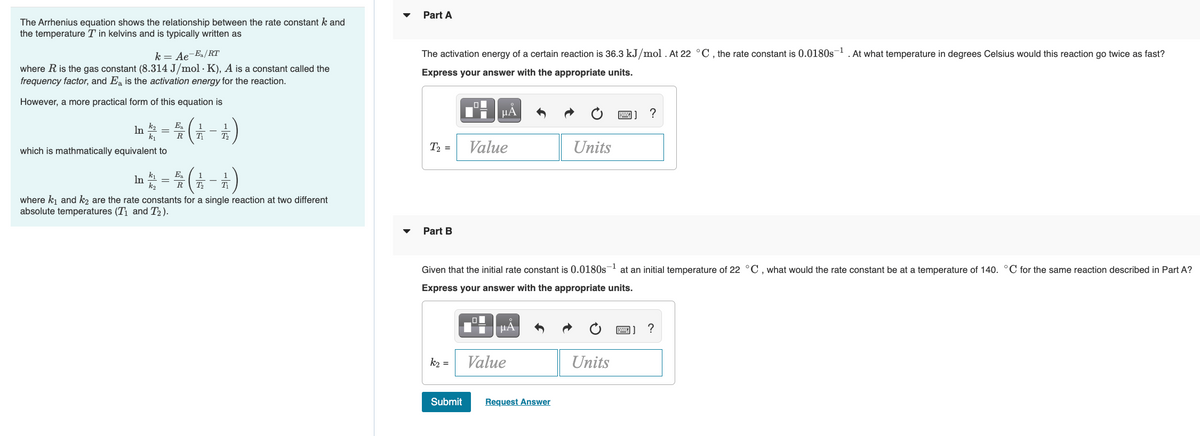Part A The Arrhenius equation shows the relationship between the rate constant k and the temperature T in kelvins and is typically written as k = Ae E/RT where Ris the gas constant (8.314 J/mol - K), A is a constant called the frequency factor, and E, is the activation energy for the reaction. The activation energy of a certain reaction is 36.3 kJ/mol. At 22 °C, the rate constant is 0.0180s. At what temperature in degrees Celsius would this reaction go twice as t Express your answer with the appropriate units. However, a more practical form of this equation is In 3(뉴 ) T = Value Units which is mathmatically equivalent to where ki and kz are the rate constants for a single reaction at two different absolute temperatures (T and T2). Part B Given that the initial rate constant is 0.0180s at an initial temperature of 22 °C, what would the rate constant be at a temperature of 140. °C for the same reaction described Express your answer with the appropriate units. kz = Value Units Submit Request Answer
Part A The Arrhenius equation shows the relationship between the rate constant k and the temperature T in kelvins and is typically written as k = Ae E/RT where Ris the gas constant (8.314 J/mol - K), A is a constant called the frequency factor, and E, is the activation energy for the reaction. The activation energy of a certain reaction is 36.3 kJ/mol. At 22 °C, the rate constant is 0.0180s. At what temperature in degrees Celsius would this reaction go twice as t Express your answer with the appropriate units. However, a more practical form of this equation is In 3(뉴 ) T = Value Units which is mathmatically equivalent to where ki and kz are the rate constants for a single reaction at two different absolute temperatures (T and T2). Part B Given that the initial rate constant is 0.0180s at an initial temperature of 22 °C, what would the rate constant be at a temperature of 140. °C for the same reaction described Express your answer with the appropriate units. kz = Value Units Submit Request Answer
Chemistry: Principles and Practice
3rd Edition
ISBN:9780534420123
Author:Daniel L. Reger, Scott R. Goode, David W. Ball, Edward Mercer
Publisher:Daniel L. Reger, Scott R. Goode, David W. Ball, Edward Mercer
Chapter13: Chemical Kinetics
Section: Chapter Questions
Problem 13.99QE
Related questions
Question
please answer all as they are part of 1 question but different questions,,.

Transcribed Image Text:Part A
The Arrhenius equation shows the relationship between the rate constant k and
the temperature T in kelvins and is typically written as
The activation energy of a certain reaction is 36.3 kJ/mol . At 22 °C , the rate constant is 0.0180s¬1 . At what temperature in degrees Celsius would this reaction go twice as fast?
k = Ae-Ea/RT
where R is the gas constant (8.314 J/mol · K), A is a constant called the
frequency factor, and Ea is the activation energy for the reaction.
Express your answer with the appropriate units.
However, a more practical form of this equation is
HA
?
In=( -)
k2
k1
Ea
1
1
R
T
T,
which is mathmatically equivalent to
T, =
Value
Units
k1
E.
In
k2
T
T
R
where ki and k2 are the rate constants for a single reaction at two different
absolute temperatures (T1 and T2 ).
Part B
Given that the initial rate constant is 0.0180s- at an initial temperature of 22 °C, what would the rate constant be at a temperature of 140. °C for the same reaction described in Part A?
Express your answer with the appropriate units.
?
k2 =
Value
Units
Submit
Request Answer
Expert Solution
This question has been solved!
Explore an expertly crafted, step-by-step solution for a thorough understanding of key concepts.
This is a popular solution!
Trending now
This is a popular solution!
Step by step
Solved in 2 steps with 2 images

Knowledge Booster
Learn more about
Need a deep-dive on the concept behind this application? Look no further. Learn more about this topic, chemistry and related others by exploring similar questions and additional content below.Recommended textbooks for you

Chemistry: Principles and Practice
Chemistry
ISBN:
9780534420123
Author:
Daniel L. Reger, Scott R. Goode, David W. Ball, Edward Mercer
Publisher:
Cengage Learning

Chemistry for Engineering Students
Chemistry
ISBN:
9781337398909
Author:
Lawrence S. Brown, Tom Holme
Publisher:
Cengage Learning


Chemistry: Principles and Practice
Chemistry
ISBN:
9780534420123
Author:
Daniel L. Reger, Scott R. Goode, David W. Ball, Edward Mercer
Publisher:
Cengage Learning

Chemistry for Engineering Students
Chemistry
ISBN:
9781337398909
Author:
Lawrence S. Brown, Tom Holme
Publisher:
Cengage Learning


Chemistry: An Atoms First Approach
Chemistry
ISBN:
9781305079243
Author:
Steven S. Zumdahl, Susan A. Zumdahl
Publisher:
Cengage Learning

Chemistry
Chemistry
ISBN:
9781305957404
Author:
Steven S. Zumdahl, Susan A. Zumdahl, Donald J. DeCoste
Publisher:
Cengage Learning

Chemistry: Principles and Reactions
Chemistry
ISBN:
9781305079373
Author:
William L. Masterton, Cecile N. Hurley
Publisher:
Cengage Learning